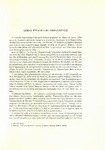| dc.creator | Μαρινάτος, Σπυρίδων | el |
| dc.date.accessioned | 2015-09-01T13:45:51Z | |
| dc.date.available | 2015-09-01T13:45:51Z | |
| dc.date.issued | 1962 | |
| dc.identifier.uri | http://hdl.handle.net/11615/16154 | en |
| dc.description.abstract | Traces of man dating from before the Neolithic period in Greece, even after the
discoveries claimed to have been made by Markowitz in Megara and by Stampfuss
in the Seidi-cave in Copais, were rather doubtful. Only after the revolutionary observations
of Prof. Milojcic in Thessaly was the Palaeolithic age established for this
region. Since then, more discoveries have been announced; in particular four
stone implements from Elis were published as Palaeolithic and one single piece
from Argolis has recently been published as belonging to the «Levalloisian type».
This last implement was found by Jameson in Riniza, not far from Ermione and published by him and by P. Bialor in AJA 66 (1962) p.p. 181 - 182, with hgures
and further bibliography.
The question of the date of such flint or obsidian implements found on the surface
of the soil, without stratigraphical evidence, still remains problematic. Typological
examination is no definite guidance. In order to help establish a more accurate
date, some implements from Kephallenia are published here for the first time,
though their study is not yet ready. They are a characteristic series of flint implements
and flakes (a few of obsidian), together with a flint arrow head. They were
collected on the surface of the soil near Skala, on the South East coast of Kephallenia.
The site is nearly two miles long and the implements are numerous. As flint is
native in Kephallenia, there is no doubt that the implements were fabricated on the
spot. There are several such places on other points of the Island and it seems that
near Chaliotata (district of Same) the number of flint implements is still greater
than at Skala.
There are mainly four chief types: a long dagger of «stiletto» section (10 cm or even
longer); broad and flat scrapers (sometimes almost 10 cm. long); triangular, very
irregular «arrowheads»; and long or short flakes of triangular or trapezoid section.
A characteristic of all these implements is that they are made by perpendicular
percussion and that they show no further finishing by side-percussion on the edges.
Only in rare examples and in the unique flint arrow-head have we the minute
splitting to give the form desired.
These facts as well as the absence of any Neolithic celt among the Kephallenian
finds seem to indicate that the flint and obsidian implements in question are, at
least partly, late and indeed very late. They may belong to an advanced stage of
the bronze-period; they may have been reproduced owing to conservatisme in these
remote Western districts, just as the hand-made plain pottery contemporaneous
with the late Mycenaean ware. Similar flint and obsidian implements are known
from other districts, particularly from Leucas. These last specimens, as far as found
in the Choirospelia-cave, may be partly Neolithic, but the greater bulk was found
in the Nidri-plain and in the Achaen tombs and surely belong to the 2nd millenary.
It is certain that the Kephallenian flint-industry exceeded local needs and that
export was made, for instance to Leucas or to Elis. It may be, that this industry
went as far as Lipari and that the obsidian found in Kephallenia was from Lipari
rather than from Melos; but further search is needed before we can say anything
more precise about this. | en |
| dc.language.iso | el | en |
| dc.publisher | Υπηρεσία Αρχαιοτήτων και Αναστηλώσεως | el |
| dc.relation.haspart | Το άρθρο συνοδεύεται από 5 πίνακες με κοινό τίτλο: "Κεφαλληνία. Λίθινα εργαλεία". (Αρχαιολογικόν Δελτίον, 1960, Τόμος 16, Κείμενον/Μέρος Α’.) http://194.177.202.105:8080/xmlui/handle/123456789/16271 | el |
| dc.rights | Attribution-NonCommercial-NoDerivatives 4.0 International | en |
| dc.rights.uri | http://creativecommons.org/licenses/by-nc-nd/4.0/ | en |
| dc.subject | Archaeology - Archeology | en |
| dc.subject | Researches | en |
| dc.subject | Tools | en |
| dc.subject | Excavations | en |
| dc.subject | Mycenaean tombs | en |
| dc.subject | Greece - Ionian islands - Cephalonia - Kefalonia | en |
| dc.subject | Αρχαιολογία | el |
| dc.subject | Έρευνες | el |
| dc.subject | Εργαλεία | el |
| dc.subject | Ανασκαφές | el |
| dc.subject | Μυκηναϊκοί τάφοι | el |
| dc.subject | Ελλάδα - Επτάνησα - Κεφαλλονιά | el |
| dc.title | Λίθινα εργαλεία εκ Κεφαλληνίας | el |
| dc.type | journalArticle | en |
| heal.recordProvider | Πανεπιστήμιο Θεσσαλίας - Βιβλιοθήκη και Κέντρο Πληροφόρησης | el |
| heal.journalName | Αρχαιολογικόν Δελτίον | el |
| heal.fullTextAvailability | true | en |
| dc.rights.accessRights | free | en |
| dc.identifier.bibliographicCitation | Αρχαιολογικόν Δελτίον, 1960, Τόμος 16, Κείμενον/Μέρος Α’, 41-45. | el |



